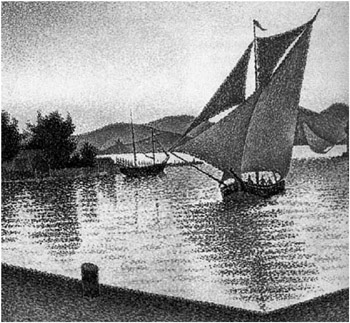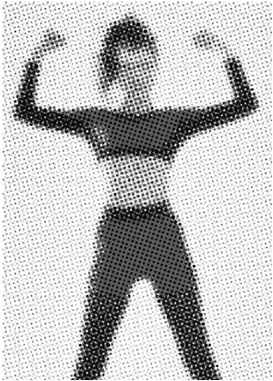Impressionism
In the nineteenth century, in an attempt to revive what was perceived to be the glories of the classical civilization of the Greeks and Romans, much of what was being produced in the art world consisted of the representational, idealized images of the Neoclassic style. In the latter part of the century, the nature of European art shifted. The Impressionist movement emerged with a fresh new approach to painting. Artists such as Claude Monet, Paul C zanne, and Mary Cassatt produced paintings that were explorations of the quality and nature of light and color .
The importance of the Impressionists contribution to the way we perceive color cannot be overstated. One particular group of Impressionists, the Pointillists ”and particularly Georges Seurat and Paul Signac (see Figure 1.4, which is also Figure C3 in the color section) ”most influenced the digital art we practice today. The Pointillists worked extensively with color theory and how one color affects the colors around it. They applied paint to the canvas in units, or little dots, not unlike the pixels on a Photoshop document or the halftone dots on a color separation. They experimented with how the eye mixes adjacent colors. Placing dots of two opposite colors ”red and green, for example ” next to each other will produce gray when seen from a distance. The relative density of the dots affects the darkness and lightness of the perceived color and its tint.

Figure 1.4: Paul Signac, The Port at Sunset, Saint-Tropez, Opus 236, 1892
Pointillism influenced the development of process printing, which uses four colors to produce full-color images. Figure 1.5 presents a close-up view of such a four-color picture (for a color view of this image, see Figure C4 in color section). In process printing, each color plate contains tiny dots of cyan, magenta , yellow, or black (CMYK). Like Pointillist painting, the densities of the colored dots on each plate influence the surrounding colors when the eye mixes them together.

Figure 1.5: Detail of a four-color process image
Photoshop is the ultimate color separator. It can configure and generate process-color separations, and separate Duotones, Tritones, Quadtones and spot colors. In addition, Photoshop has filters that enable you to simulate Impressionist and other painterly effects.
EAN: 2147483647
Pages: 355